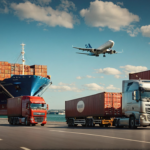International trade has been working for hundreds of years. From the first ship that carries food from one country to another till today, it has changed a lot. The Internet and innovations in technology and machines have contributed to most of those changes. Here you will find all you need to know about international trade.
International trade
International trade was born thanks to globalization. It allows countries to make commercial transactions beyond the capacity of their own domestic markets. The idea is to sell what other countries need and to buy what your country does not have. So, it basically consists in importing and exporting goods and services throughout the whole world.
The importance of international trade has grown a lot over the past 70 years as countries become more interconnected. Due to the capitalist economic system that has been spreading around the world, nations have become increasingly close economically. If before it was necessary to face months of travel in scurvy sailing ships to search for spices in the Americas, today it is possible to cross the world in 24 hours without major problems. Despite the numerous advances, many challenges still lie ahead in international trade. Economic, logistical, social, and environmental challenges, from which many opportunities are born.

Who makes the rules?
Before the II World War, trade was regulated through bilateral treaties between two countries. But, once this finishes, multilateral treaties, such as General Agreement on Tariffs and Trade (GATT) and World Trade Organization (WTO) emerged for regulating global trade as the principal regime. WTO was created in 1995 as the successor to the GATT, and it is in charge of overseeing and adjudicating international trade. It also deals with the rules of trade between nations and is responsible for implementing and negotiating new agreements for trade.
Opportunities in international trade
As we mentioned in one of our previous articles “How to survive the 2023 crisis”, there is a big recession coming in 2023. It brings several consequences for international trade, your supply chain and logistics, and the end customers. However, there are still opportunities for you and your business.
In spite of the coming recession, international trade allows you to expand your business borders by getting your raw materials from anywhere, installing your production processes throughout the world, and selling them or offering services around the globe. All this is possible through innovations in technology and transportation. In other words, if you manage your logistics in a proper way the possibilities that international trade offers will be at your disposal.
But, how can you leverage this chance of working beyond your borders? The answer is digital transformation for your supply chain and logistics. Applying the Internet of Things (IoT), Machine Learning, Artificial Intelligence, and Data integration, among others, lead your supply chain to become more connected, improve its capacity of being resilient against contingencies, and increase your ROI.
You can take advantage of the possibilities of international trade by applying digital technologies to your supply chain and logistics Click To TweetSo, despite the uncertainties that the coming crisis will bring to the international market, your business and supply chain can survive and take advantage of them by applying digital technology. If you want to get the proper technology for your logistics, you are in the right place.


















